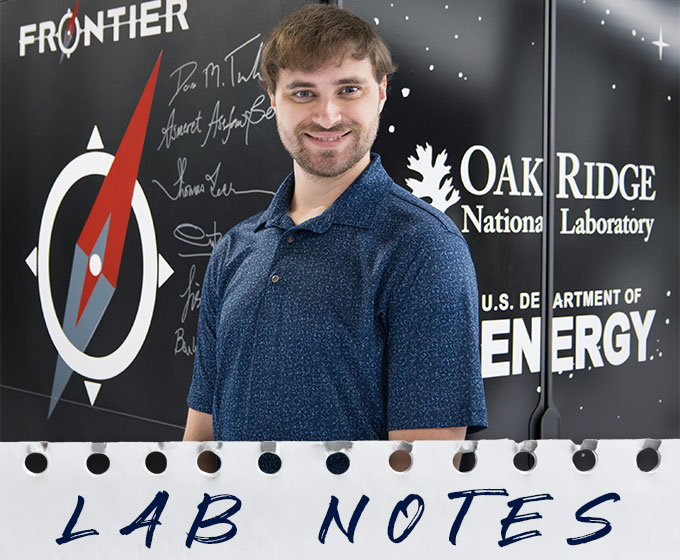
Kevin Posladek in front of the Frontier supercomputer.
Editor’s note: This summer, we’re shining a spotlight on Roadrunner researchers and the innovative work they are doing in labs across campus and beyond. Today, we checked in with a student spending his summer working in a National Laboratory.
JULY 28, 2025 — Testing the aerodynamics of rockets in a Mach 7 wind tunnel that emulates the extreme speed of a spacecraft’s descent back to Earth is a highly anticipated assignment among students working in the UTSA Hypersonics Lab.
The task helps to advance the quest for sleeker spacecraft designs and seamless landings. But the rewarding work and fun doesn’t stop there.
Select students also get to work at the Oak Ridge National Laboratory (ORNL), a multiprogram research laboratory in Oak Ridge, Tenn., managed by a nonprofit entity for the Department of Energy. The lab employs a world-class supercomputer to run simulations and discover whether their modeling of physics matches what’s happening in the wind tunnel.
— Kevin Posladek
Kevin Posladek, a PhD candidate in mechanical engineering, began his work in the Hypersonics Lab working under advisor and lab director Christopher Combs, the Dee Howard Endowed Associate Professor in Aerodynamics in the UTSA Department of Mechanical Engineering. He later joined the Graduate Research Program at Oak Ridge.
This experience led Posladek to pivot his research from experimental to computational, and learning the “ins and outs of computer simulations,” he said, seeing a more holistic view of the design process.
“What I think is most valuable in this program is the exposure to the other half of the research field that I’m in,” Posladek said. “It’s really exciting to have access to some of the best scientists and computational tools in the country to approach the research that I’m passionate about from a new angle.”
During summer 2025, Posladek has been particularly focused on the common dangers in space travel, known as shock-shock and shock-boundary-layer interactions.
A shock-shock interaction occurs when two or more shock waves collide, creating new, potentially destructive shock waves, increasing pressure or generating intense heat that could melt a spacecraft.
A shock-boundary-layer interaction occurs when a shock wave hits the air clinging to an object’s surface due to friction. The disruption to this air layer can cause turbulence and drag similar to a hole in the bottom of a sled.
Posladek described the experimental and computational work as operating in tandem with an ongoing feedback loop.
“Computer simulations are a powerful tool for the design of vehicles but these models need to be validated with real-world data so we know that solutions from the computer are reliable,” he said. “That’s where we at UTSA come in — we provide our experimental data to ORNL, and with that, ORNL can validate the computational models that they’ve developed.”
The hope is that what takes place in the simulation mirrors what unfolds in the experiment, indicating that both tests have been designed and executed correctly.
“If we see good agreement between the experimental and the simulation data, I will be able to explore the physics further with the results from the simulation, which, if correct, affords a lot more data than I would be able to get in a wind tunnel,” he added.
Posladek hopes that the progress he and his team make this summer at Oak Ridge will support the design of future vehicles.
“Spacecraft reenter Earth’s atmosphere at hypersonic speeds, so the research we do has real, practical applications in making space travel safer and more efficient,” he said.
UTSA Today is produced by University Communications and Marketing, the official news source of The University of Texas at San Antonio. Send your feedback to news@utsa.edu. Keep up-to-date on UTSA news by visiting UTSA Today. Connect with UTSA online at Facebook, Twitter, Youtube and Instagram.
Move In To COLFA is strongly recommended for new students in COLFA. It gives you the chance to learn about the Student Success Center, campus resources and meet new friends!
Academic Classroom: Lecture Hall (MH 2.01.10,) McKinney Humanities BldgWe invite you to join us for Birds Up! Downtown, an exciting welcome back event designed to connect students with the different departments at the Downtown Campus. Students will have the opportunity to learn about some of the departments on campus, gain access to different resources, and collect some giveaways!
Bill Miller PlazaJoin us for an intimate evening of cocktails, conversation, and culinary inspiration with Pati Jinich, Emmy-nominated chef and James Beard Award-winning author. Enjoy light bites and signature drinks in the warm, modern setting of Mezquite as Pati connects with guests over her passion for Mexican cuisine and storytelling.
Mezquite Restaurant in Pullman Market, 221 Newell Ave., San Antonio 78215From inspired courses to thoughtful pairings and a rich sense of community, the Ven a Comer Signature Dinner is a night of shared meals, shared stories, and unforgettable flavor.
Stable Hall (Pear Brewery), 307 Pearl Pkwy, San Antonio 78215Come and celebrate this year's homecoming at the Downtown Campus with food, games, giveaways, music, and more. We look forward to seeing your Roadrunner Spirit!
Bill Miller PlazaThe University of Texas at San Antonio is dedicated to the advancement of knowledge through research and discovery, teaching and learning, community engagement and public service. As an institution of access and excellence, UTSA embraces multicultural traditions and serves as a center for intellectual and creative resources as well as a catalyst for socioeconomic development and the commercialization of intellectual property - for Texas, the nation and the world.
To be a premier public research university, providing access to educational excellence and preparing citizen leaders for the global environment.
We encourage an environment of dialogue and discovery, where integrity, excellence, respect, collaboration and innovation are fostered.